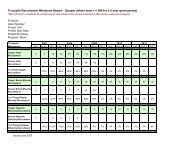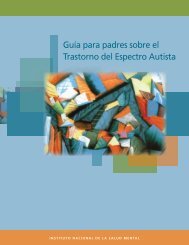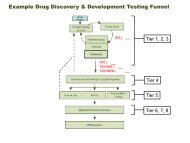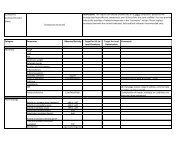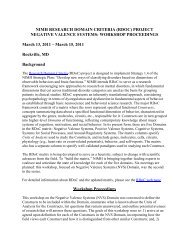Brain's Inner Workings: Teacher's Manual - NIMH
Brain's Inner Workings: Teacher's Manual - NIMH
Brain's Inner Workings: Teacher's Manual - NIMH
You also want an ePaper? Increase the reach of your titles
YUMPU automatically turns print PDFs into web optimized ePapers that Google loves.
1. The mazes from the Web site aren’t<br />
guaranteed to be of equal difficulty.<br />
What technique did you use to try to<br />
minimize this source of error?<br />
Averaging and random assignment of<br />
mazes minimizes error.<br />
2. Use the diagram at the right to indicate<br />
which parts of the brain were involved<br />
in the tasks: shade the areas required to<br />
do the basic maze in grey (pencil), the<br />
area that analyzes music in red, the area<br />
that generates speech in blue, and the area<br />
that responds to odors in green.<br />
Image source http://pubs.niaaa.nih.gov/publications/<br />
aa63/images/brain.gif<br />
Students should realize that many areas of the brain must work together to solve a maze. The occipital<br />
lobe is responsible for vision, the parietal lobe is the center of visual attention and goal-directed<br />
voluntary movements, and the cerebellum for fine motor coordination. Broca’s area (for speech) is located<br />
in the inferior frontal gyrus. The temporal lobes are responsible for hearing. Odor is detected by the<br />
piriform cortex, a portion of the primary olfactory cortex.<br />
It’s also important for students to realize that the mazes may be only approximately equal in difficulty.<br />
Some subjects could be right- or left-dominant, and find certain turns easier to perceive than others. Only<br />
a large number of subjects would reduce this source of error.<br />
Some of the first quantitative studies of the<br />
performance of rats in mazes were completed by<br />
American psychologist Karl Lashley in the 1920s.<br />
Lashley would allow a rat to complete a maze to get<br />
food again and again. He would then create lesions<br />
in various areas of the cerebral cortex, and then<br />
measure whether the rat could still complete the<br />
maze. But Lashley thought that all areas of the cortex<br />
were more or less equivalent. His student, Donald<br />
Hebb, began the work to localize specific cortical<br />
areas for vision, hearing, and spatial discrimination.<br />
22 The Brain’s <strong>Inner</strong> <strong>Workings</strong>: A Guide for Teachers<br />
Na t i o n a l Institute of Me n t a l He a l t h



